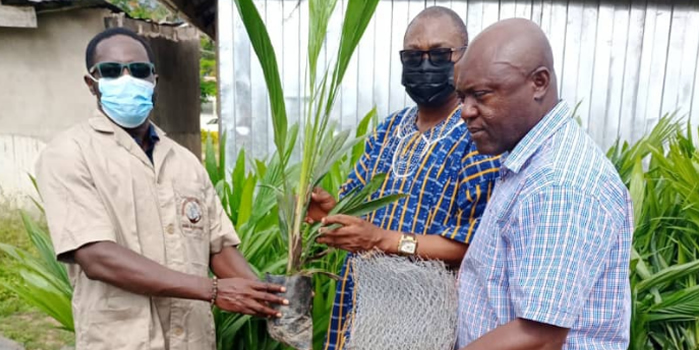

Crop Farming
The major economic activity in the Municipality is farming. Unlike in other parts of the country, where farming is left in the hands of the elderly, people of all ages in the Municipality are involved in farming due to the high returns derived particularly from cocoa production. The other major cash crops grown in the Municipality are coffee, oil palm, rubber, citrus and black pepper as well as coconut.
Cocoa Buying Companies operate in the Municipality. These companies offer employment to a sizeable number of the youth as either purchasing clerks, security men, labourers and drivers. However, they contribute little directly to internally generated funds of the Municipal Assembly because they are not taxed for the cocoa they export from the Municipality.
The Municipality also has comparative advantage in the cultivation of food crops. Plantain, yam, cassava, cocoyam, vegetables, rice and maize among others are widely cultivated in the Municipality. The main problems facing food crops farmers are high cost of farm inputs, low prices of farm produce particularly during the main (harvesting) season.
The arable lands in the Municipality are mainly used for the cultivation of cocoa and oil palm. Consequently, the land available for food crops cultivation is declining proportionately which can cause food deficit in the Municipality.
Fish Farming
Fish Farming is fast catching up with farmers in the Municipality. There are relatively a sizeable number of about 60 fish ponds in the Municipality in 2014 has increased to 80 fish ponds. The common species of fish reared are tilapia and catfish. The Municipality Directorate of Food and Agriculture records show that an average of about 5 tonnes of fish which was harvested annually has now increased to 8 tonnes in 2017.
The Municipality has enormous potential for fish farming but this has not been fully tapped. The challenge faced by fish farmers in the Municipality is the absence of specialised breeding points (hatcheries) for fingerlings. Fish farming, if effectively packaged and marketed to the various communities, could add to the dietary and economic well-being of farmers especially during the lean cocoa season.
Livestock Farming
Most households rear animals for domestic consumption. There are a few households which rear animals for commercial purposes just to supplement incomes from cocoa and other sources. The major livestock reared in the Municipality include cattle, sheep, goats, pigs, rabbits, guinea fowls and poultry. With regard to non-traditional livestock, grasscutter production, bee keeping and snail rearing have been identified as potential economic activities in the District thereby creating employment and increasing income of the people.
Lumbering
The Municipality has large tracts of forest with different timber species that make the Municipality a potential destination for timber exploitation or lumbering activities. Despite the abundance of timber species, there are no timber firms or sawmills established in the Municipality. All the timber firms that have utilisation permits are located outside the Municipality. For example, Omega Wood Processing Company Ltd, Ghana Prime Wood Product, Suadam Company Ltd and four others based Kumasi and Takoradi are some of the timber firms exploiting timber in the Municipality.
There is also the presence of illegal chainsaw operators in the Municipality, whose activities are gradually degrading the forest and the environment in general. Lumbering as an economic activity could become a great source of employment for the unemployed youth in the Municipality. However, the current rate of exploitation of timber poses a serious threat to the environment, especially the forest reserves.
Food Security
The soil conditions favour the cultivation of varieties of tree crops and food crops. Livestock production and general agriculture have great potential in the Municipality. The soil in the Municipality is part of the forest ochrosols and support large scale production of food crops including plantain, cassava, rice, cocoyam and food baskets in the region. Reports from the Department of Agriculture indicates that all the major food crops such as cassava, yam, cocoyam, plantain and palm oil are produced in sufficient quantities in the district except maize and rice. With the introduction and implementation of the Planting for Food and Jobs Programme and the European Union Grant Support Project to local food crops farmers, coupled with the good weather condition prevailing, the Municipality the potentials to overcome the deficit in maize and rice in the not too distant future.
Also the vibrant markets in the Municipality like the Bibiani, Bekwai and Pataboso junction markets contribute considerably to the effective distribution of these farm produce. Moreover, since the Municipality is mainly an agrarian economy most households get access to food from their own farms. There is availability of food throughout the year at reasonable prices. This had ensured that most households have access to at least two square meals a day
One disturbing trend in the Municipality is that the choice lands are being used for cocoa cultivation. When this trend is not checked, in the very near future, food production will decline with its attendant high 73 prices of food stuff. This could lead to social unrest resulting in stealing, sexual promiscuity and armed robbery.
Date Created : 5/4/2023 12:00:00 AM













 facebook
facebook
 twitter
twitter
 Youtube
Youtube
 +233 593 831 280
+233 593 831 280 0800 430 430
0800 430 430 GPS: GE-231-4383
GPS: GE-231-4383 info@ghanadistricts.com
info@ghanadistricts.com Box GP1044, Accra, Ghana
Box GP1044, Accra, Ghana